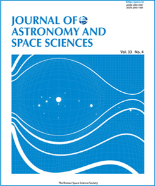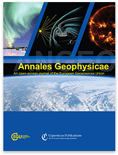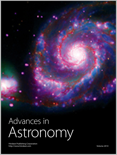
EXPERIMENTAL ASTRONOMY
Scope & Guideline
Unveiling Celestial Secrets through Experimental Science
Introduction
Aims and Scopes
- Instrumentation and Technology Development:
Research that involves the design, testing, and calibration of new astronomical instruments, including telescopes, detectors, and sensors to improve data acquisition and analysis. - Observational Techniques:
Studies that emphasize novel methodologies for observing celestial phenomena, including spectropolarimetry, astrometry, and time-domain astronomy. - Astrophysical Applications:
Application of developed technologies and methodologies to address specific astrophysical questions, such as the nature of cosmic rays, the study of exoplanets, and the characterization of cosmic microwave background radiation. - Data Processing and Analysis:
Innovative approaches to data handling, including machine learning and statistical methods, aimed at improving the interpretation of large astronomical datasets. - Collaboration and Mission Concepts:
Research that discusses collaborative efforts in space missions and concepts for future astronomical explorations, integrating various scientific disciplines.
Trending and Emerging
- Machine Learning and Data Science Applications:
There is a growing trend in utilizing machine learning and data science techniques for astronomical data analysis, enabling more efficient processing of large datasets and improving classification and prediction accuracy. - Space-Based Missions and Innovations:
An increase in research related to new space missions, such as the Ariel mission and others, indicates a strong focus on developing technologies for exploration beyond Earth, including exoplanet studies and cosmic observations. - High-Energy Astrophysics:
Research centered on high-energy astrophysical phenomena, including gamma-ray bursts and cosmic rays, has gained prominence as new instruments and missions are developed to explore these areas more thoroughly. - Astrobiology and Habitability Studies:
Emerging themes in astrobiology, especially those exploring the habitability of exoplanets and characterizing planetary atmospheres, indicate a rising interest in understanding life beyond Earth. - Interdisciplinary Approaches and Collaborations:
There is an increasing trend toward interdisciplinary research and collaborations across fields such as physics, engineering, and planetary science, emphasizing holistic approaches to complex astronomical questions.
Declining or Waning
- Traditional Ground-Based Observational Techniques:
There has been a noticeable decrease in publications focusing on conventional ground-based observational techniques, likely due to the increasing emphasis on space-based missions and advanced instrumentation. - Theoretical Modelling Without Experimental Validation:
Research papers that solely focus on theoretical models without accompanying experimental or observational validation have become less frequent, reflecting a growing demand for empirical data. - General Cosmology Studies:
While cosmology remains an important field, there's a decline in generic studies that do not utilize cutting-edge technology or innovative observational methods, as the journal prioritizes novel approaches. - Longitudinal Studies of Known Objects:
Research centered on the longitudinal study of well-known celestial bodies seems to be waning, possibly due to the shift towards exploring new and unexplored regions of the universe. - Basic Calibration Techniques:
Papers focused solely on basic calibration methods without innovative advancements or applications have decreased, as the journal increasingly favors research that contributes significantly to instrument performance.
Similar Journals

Open Astronomy
Pioneering Open Access in the Realm of Astronomy.Open Astronomy is a pioneering journal dedicated to the expansive field of astronomy and astrophysics, published by De Gruyter Poland Sp. z o.o. since 2016. This Open Access journal aims to facilitate the dissemination of high-quality research and stimulate scholarly dialogue among researchers, professionals, and students on a global scale. With a commitment to fostering the accessibility of academic knowledge, Open Astronomy has established itself within reputable categories, achieving a Q3 ranking in Astronomy and Astrophysics and a Q4 position in Space and Planetary Science for 2023. The journal also ranks 66th out of 90 in the Astronomy and Astrophysics category and 84th out of 104 in Space and Planetary Science according to Scopus metrics, indicating its growing influence in the scientific community. Based in Warsaw, Poland, Open Astronomy invites contributions that explore novel discoveries, innovative methodologies, and theoretical advances in the field, making it a vital resource for anyone passionate about the cosmos.

Journal of Astronomy and Space Sciences
Exploring the Cosmos, One Discovery at a Time.The Journal of Astronomy and Space Sciences, published by the Korean Space Science Society, is a premier open-access platform dedicated to advancing the fields of astronomy, astrophysics, and space sciences. Established in 1984, the journal has been instrumental in disseminating high-quality research findings, fostering collaboration among scientists globally, and providing insights into the dynamics of our universe. With an ISSN of 2093-5587 and an E-ISSN of 2093-1409, the journal has gained notable recognition, currently ranking in the Q3 quartile in Earth and Planetary Sciences and Physics and Astronomy as of 2023. Although the journal's H-Index is currently unspecified, its commitment to rigorous peer-review processes and open-access availability ensures that groundbreaking research is accessible to a wide audience. Based in Seoul, South Korea, the journal is poised to continue supporting innovative research through 2024 and beyond. Researchers, professionals, and students alike will find valuable resources and opportunities within its pages, further establishing this journal as a crucial resource in the exploration of the cosmos.

Frontiers in Astronomy and Space Sciences
Innovating Research to Expand Our Celestial UnderstandingFrontiers in Astronomy and Space Sciences is a leading open access journal published by FRONTIERS MEDIA SA, based in Switzerland. Since its inception in 2015, this journal has provided a dynamic platform for researchers, professionals, and students to disseminate their findings across a wide spectrum of topics within the field of astronomy and astrophysics. With an impressive 2023 Impact Factor reflecting its relevance and contribution to the scientific community, it ranks in the Q2 category in Astronomy and Astrophysics, demonstrating a solid reputation among peers. The journal's commitment to open access ensures that all published research is freely available, fostering greater collaboration and knowledge sharing among astronomers worldwide. With a diverse range of articles spanning from theoretical investigations to observational studies, Frontiers in Astronomy and Space Sciences is an essential resource for anyone seeking to explore the wonders of the universe and share innovative ideas that push the boundaries of our understanding.

ACTA ASTRONOMICA
Charting New Frontiers in Astronomy: Join the Journey of DiscoveryACTA ASTRONOMICA, the esteemed journal published by the COPERNICUS FOUNDATION POLISH ASTRONOMY, is a pivotal platform for disseminating significant advancements in the fields of Astronomy, Astrophysics, and Space Science. With an established history spanning from 1996 to 2023, this journal maintains a strong position in academia, evidenced by its Q2 ranking in both Astronomy and Astrophysics as well as Space and Planetary Science categories. Targeted at researchers, professionals, and students, ACTA ASTRONOMICA offers a comprehensive collection of articles that foster a deeper understanding of celestial phenomena, planetary exploration, and theoretical advancements in the universe. While it is not an open-access journal, its structured format caters to a global audience eager to engage with cutting-edge research. Notably, its Scopus rankings highlight its relevance, placing it in the 56th percentile for Astronomy and Astrophysics and the 44th percentile for Space and Planetary Science, ensuring that contributors are part of an influential community that is shaping the future of astronomical study.

ANNALES GEOPHYSICAE
Connecting Ideas in Astronomy, Atmospheric Science, and Earth ScienceANNALES GEOPHYSICAE is a distinguished open access journal published by COPERNICUS GESELLSCHAFT MBH, renowned for its contributions to the field of geophysics and related disciplines. Since its inception in 1996 as an open access journal, ANNALES GEOPHYSICAE has provided a vital platform for researchers to disseminate their findings covering a wide array of topics within Astronomy and Astrophysics, Atmospheric Science, and Earth and Planetary Sciences. The journal enjoys a commendable reputation, evidenced by its impressive 2023 category quartiles, ranking Q1 in Earth and Planetary Sciences (miscellaneous) and Q2 in several other relevant categories, reflecting its significance in the global research community. Based in Germany and accessible to a diverse audience, ANNALES GEOPHYSICAE serves as an essential resource for academics, practitioners, and students alike, striving to foster advancements in our understanding of geophysical phenomena and encouraging collaboration across disciplines.

Journal of the Korean Astronomical Society
Innovative Discoveries: Shaping the Future of Space ScienceWelcome to the Journal of the Korean Astronomical Society, an esteemed publication dedicated to advancing the fields of Astronomy and Astrophysics as well as Space and Planetary Science. Established in 1993 and under the reputable auspices of the Korean Astronomical Society, this journal serves as a vital platform for researchers and scholars from South Korea and around the globe to disseminate innovative findings and critical insights. With a commendable Q2 ranking in Astronomy and Astrophysics and a Q3 ranking in Space and Planetary Science, this journal is positioned among the influential voices in its fields, fostering collaboration and knowledge exchange. The journal's rigorous peer-review process ensures that published works contribute significantly to ongoing discussions and developments in astronomical research. While currently not an open-access journal, it remains accessible to the academic community, encouraging readers to stay abreast of the latest advancements in the sciences that elucidate the universe's complexities. Join us in exploring the cosmos through cutting-edge research and scholarly discussion that propels the field forward.

Advances in Astronomy
Exploring the Cosmos, One Discovery at a Time.Advances in Astronomy is a prestigious open-access journal published by HINDAWI LTD, dedicated to the field of astronomy and astrophysics. Established in 2008, the journal aims to disseminate significant research findings and advancements in the understanding of celestial phenomena, planetary sciences, and the intricate workings of the universe. With an impact factor that reflects its relevance in the scholarly community, Advances in Astronomy holds a commendable rank of Q3 in both Astronomy and Astrophysics as well as Space and Planetary Science categories, indicating its importance within these fields. The journal also showcases a commitment to open-access publishing, ensuring that research is readily available to both the scientific community and the public. Researchers, professionals, and students alike are encouraged to contribute to this dynamic forum to share knowledge and foster collaboration in exploring the wonders of the cosmos.

JOURNAL OF ASTROPHYSICS AND ASTRONOMY
Charting New Frontiers in Cosmic Understanding.JOURNAL OF ASTROPHYSICS AND ASTRONOMY, published by the Indian Academy of Sciences, stands as a pivotal resource for researchers and professionals in the fields of astrophysics and astronomy, with a rich history of publication dating back to 1980. This esteemed journal aims to disseminate high-quality research, fostering advancements in how we understand celestial phenomena, space environments, and planetary sciences. With a current Impact Factor that places it in the Q3 category for both Astronomy and Astrophysics and Space and Planetary Science, it maintains a crucial role in the global academic community, particularly within India. Although not an open access journal, its scholarly contributions are vital for both emerging and established researchers striving to push the boundaries of our knowledge in the cosmos. The journal is indexed in Scopus, ranking 56th in Astronomy and Astrophysics and 72nd in Space and Planetary Science, reflecting its ongoing significance and reach in the scientific dialogue.

Romanian Astronomical Journal
Exploring the depths of Astronomy and Astrophysics.Welcome to the Romanian Astronomical Journal, a distinguished publication operating under the esteemed EDITURA ACAD ROMANE, dedicated to advancing the field of Astronomy and Astrophysics. With a rich tradition rooted in Romania, this journal aims to foster scholarly discourse and disseminate pivotal research findings within the cosmic sciences. Although currently not designated as Open Access, the journal remains committed to ensuring that its content meets rigorous academic standards. The Romanian Astronomical Journal holds a commendable position in the academic community, achieving a Q3 ranking in Astronomy and Astrophysics and a Q4 ranking in Space and Planetary Science for 2023, reflecting its contribution to the scientific landscape. With a focus on originality and scholarly excellence, this journal serves as a vital resource for researchers, professionals, and students alike, promoting a deeper understanding of the universe and our place within it. Positioned at the intersection of innovative research and practical application, the Romanian Astronomical Journal invites contributions that push the boundaries of knowledge in our field.

ASTROPHYSICS
Pioneering Insights: Advancing the Frontiers of AstrophysicsASTROPHYSICS, published by Springer/Plenum Publishers, stands as a crucial platform for the dissemination of groundbreaking research in the field of Astronomy and Astrophysics. Established in 1965 and continuing its legacy until 2024, the journal highlights significant advancements, theoretical frameworks, and observational data that collectively push the boundaries of our understanding of the universe. Although currently categorized in the Q4 quartile for Astronomy and Astrophysics and holding a Scopus rank within the 17th percentile, ASTROPHYSICS remains dedicated to offering rigorous peer-reviewed content that is essential for researchers, professionals, and students alike. While it does not provide open access, the journal's accessibility through institutional subscriptions ensures a wide reach among the academic community, allowing it to address the rising curiosity surrounding cosmic phenomena and contribute meaningfully to ongoing scholarly discourse. For those seeking to engage with the latest findings and methodologies in astrophysics, ASTROPHYSICS continues to serve as an indispensable resource.